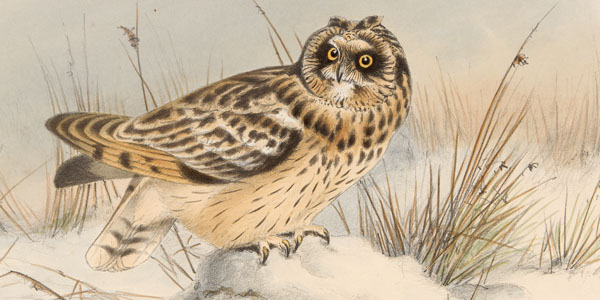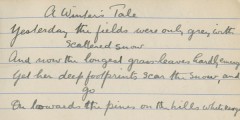12 December: Short-eared snow owl in a snowy landscape
December 12, 2011
This drawing of a short-eared owl is held in the Porter Collection and is from a time when specimens were shot and collected to provide knowledge of different species. Drawn by artist E Neale, the image features in ET Booth’s volume Rough notes on the birds observed during twenty-five years’ shooting and collecting in the …
8 December: A Christmas Croak
December 8, 2011
This is the opening to ‘A Christmas Croak’ which was first published in 1861 and is an alternative version of Christmas favourite God Rest Ye Merry Gentlemen. Robert Brough’s miscellany A cracker bon-bon for Christmas parties: consisting of Christmas pieces for private representation and other seasonable matter, in prose and verse, in which the song …
6 December: the Christmas Tree for all young people
December 6, 2011
Today’s featured item from Manuscripts and Special Collections is an illustrated copy of George F Pardon’s The Christmas Tree for all Young People (London, 1857). The book was originally designed for the amusement and instruction of all young people at Christmas. As with other items in the Briggs Collection, its cover illustrates the 19th century …
5 December: Snow Posset
December 5, 2011
While it sounds like a Christmassy drink that wouldn’t look out of place alongside mulled wine or eggnog, a snow posset was originally concocted in the hope of alleviating minor ailments. Written in 1743 by Henrietta Harley, Countess of Oxford, the recipe for snow …
3 December: A Winter’s Tale
December 3, 2011
This copy of DH Lawrence’s ‘A Winter’s Tale’ is from a notebook belonging to the famous writer while at University College Nottingham. Lawrence was at the College between 1906 and 1908, and the notebook was originally used for his Latin studies before he decided to use the space to draft his wintry poem. We recruited …
2 December: Robin red-breast
December 2, 2011
This beautiful illustration of a robin features in one of about 650 ornithological books that form part of the University’s Porter Collection. Out of all the birds in the extensive collection, the robin is by far the most heavily associated with the festive period – but why is that? And why exactly do we put …






